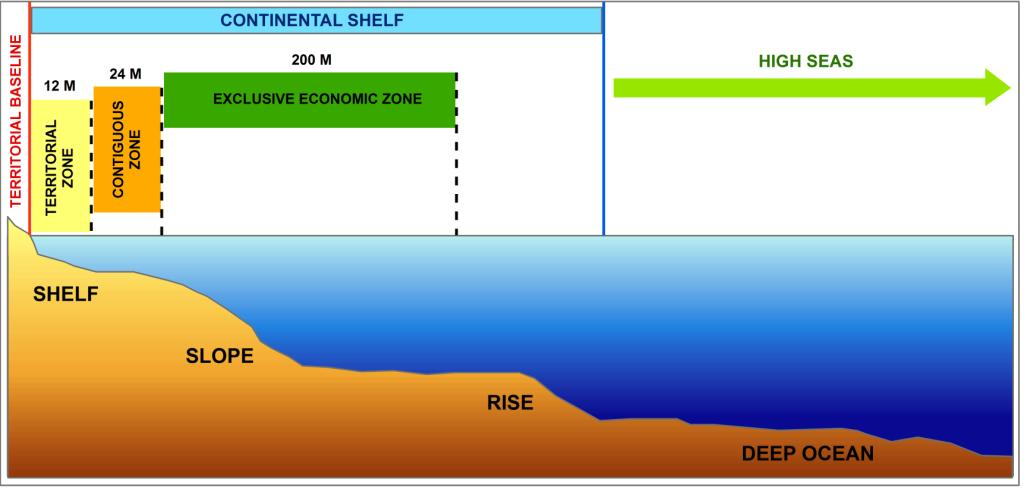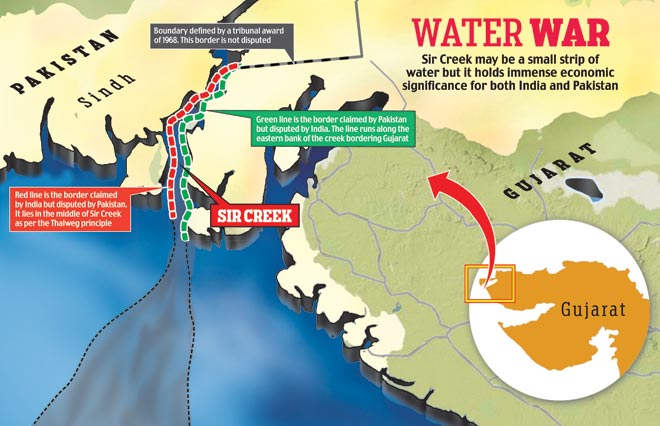Important Facts For Prelims
India’s Extended Continental Shelf Claim
- 28 Apr 2025
- 8 min read
Why in News?
India has submitted a modified claim to the United Nations Commission on the Limits of the Continental Shelf (CLCS) to extend its Extended Continental Shelf in the Central Arabian Sea by nearly 10,000 square kilometers, aiming to secure valuable seabed resources while avoiding a maritime dispute with Pakistan.
What is the Extended Continental Shelf?
- Extended Continental Shelf (ECS): The continental shelf under UNCLOS includes the seabed and subsoil of submarine areas extending beyond a coastal State’s territorial sea, either up to the natural edge of the continental margin or up to 200 nautical miles from its baselines, whichever is farther.
- The Extended Continental Shelf refers to the seabed area that extends beyond the 200 nautical miles limit of the exclusive economic zone (EEZ) and is an extension of a country's continental shelf
- Exclusive Economic Zone (EEZ): Coastal nations, including India, are entitled to an EEZ extending 200 nautical miles from their coastline.
- This grants them exclusive rights for resource extraction, including fishing and seabed mining.
- The UN CLCS facilitates the implementation of the United Nations Convention on the Law of the Sea (UNCLOS).
What is India’s Current Extended Continental Shelf Claim?
- Initial Submission (2009): India submitted its ECS claim to the UN CLCS, covering parts of the Bay of Bengal, Indian Ocean, and Arabian Sea, seeking rights over the seabed beyond its EEZ.
- Objections and Review: In 2021, Pakistan objected to India's claim in the Western Arabian Sea, citing a 100-nautical-mile overlap near the disputed Sir Creek area.
- In 2023, the CLCS rejected India's claim in the Arabian Sea but allowed resubmission with modifications.
- Modified Submission (2025): India revised its claim by splitting the Western Arabian Sea submission into two parts, avoiding the disputed area and adding nearly 10,000 sq km in the Central Arabian Sea.
- This strategic move aims to secure seabed areas rich in minerals, polymetallic nodules, and oil reserves critical for India’s economic interests.
- Current Status: India's amended submission will be reviewed in the 64th CLCS session (August 2025), with recommendations to be made under Article 76 of UNCLOS.
- Article 76 of the UNCLOS defines the continental shelf and establishes rules for determining its outer limits.
Note: India's continental shelf claims in the Arabian Sea overlap with Oman's, but both countries have an agreement since 2010 stating that the area is "not under dispute" despite not being delimited.
- India has claimed 300,000 square km in the Bay of Bengal and the Indian Ocean, though Myanmar and Sri Lanka contest it.
What is the Significance of Extended Continental Shelf for India?
- Strategic Control and Maritime Sovereignty: India's seabed and sub-seabed area, with the addition of 1.2 million sq. km from its extended continental shelf claims, will nearly match its land area of 3.274 million sq. km, reinforcing its maritime sovereignty and enhancing its strategic autonomy.
- By asserting ECS rights, India boosts its influence in the Indian Ocean, playing a larger role in maritime diplomacy and regional collaborations on resource management.
- Economic Growth & Blue Economy: The ECS unlocks potential for sectors like fisheries, offshore energy, and marine biotechnology, contributing to the growth of India's Blue Economy.
- Scientific & Environmental Stewardship: India’s claim promotes oceanographic research, ensuring sustainable management of marine resources in line with global environmental norms.
Sir Creek
- It is a 96-km water strip located in the Rann of Kutch marshlands, disputed between India and Pakistan.
- Sir Creek roughly separates the Kutch region in India and Pakistan’s Sindh province and opens into the Arabian Sea.
- The international boundary in the Sir Creek area and International Maritime Boundary line (IMBL) between India and Pakistan have not been demarcated.
UPSC Civil Services Examination Previous Year Question (PYQ) nation
Prelims
Q1. With reference to ‘Indian Ocean Rim Association for Regional Cooperation (IOR-ARC)’, consider the following statements: (2015)
- It was established very recently in response to incidents of piracy and accidents of oil spills.
- It is an alliance meant for maritime security only.
Which of the statements given above is/ are correct?
(a) 1 only
(b) 2 only
(c) Both 1 and 2
(d) Neither 1 nor 2
Ans: (d)
Exp:
- Indian Ocean Rim Association for Regional Cooperation (IOR-ARC) is a regional cooperation initiative of the Indian Ocean Rim countries which was established in Mauritius in March 1997 with the aim of promoting economic and technical cooperation among its members. Hence, statement 1 is not correct.
- IOR-ARC is the only pan-Indian ocean grouping. It has 23 Member States and 9 Dialogue Partners.
- It aims to create a platform for trade, and socio-economic and cultural cooperation in the Indian Ocean Rim area, which constitutes a population of about two billion people. Hence, statement 2 is not correct.
- The Indian Ocean Rim is rich in strategic and precious minerals, metals and other natural resources, marine resources, and energy, all of which can be sourced from Exclusive Economic Zones (EEZ), continental shelves, and the deep seabed. Therefore, option (d) is the correct answer.
Q2. Consider the following statements: (2021)
- The Global Ocean Commission grants licences for seabed exploration and mining in international waters.
- India has received licences for seabed mineral exploration in international waters
- ‘Rare earth minerals’ are present on the seafloor in international waters.
Which of the statements given above are correct?
(a) 1 and 2 only
(b) 2 and 3 only
(c) 1 and 3 only
(d) 1, 2 and 3
Ans: (b)
Mains
Q. Critically evaluate the various resources of the oceans which can be harnessed to meet the resource crisis in the world. (2014)






